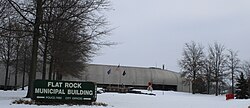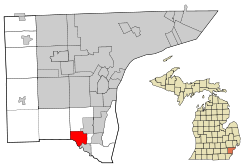Flat Rock, Michigan
| Flat Rock, Michigan | |
|---|---|
| City | |
| City of Flat Rock | |

The Flat Rock Municipal Building at Gibraltar Road in December 2010
|
|
 Location in Wayne County and the U.S. state of Michigan |
|
| Coordinates: 42°6′7″N 83°16′22″W / 42.10194°N 83.27278°WCoordinates: 42°6′7″N 83°16′22″W / 42.10194°N 83.27278°W | |
| Country | United States |
| State | Michigan |
| Counties | Monroe, Wayne |
| Area | |
| • Total | 6.67 sq mi (17.28 km2) |
| • Land | 6.53 sq mi (16.91 km2) |
| • Water | 0.14 sq mi (0.36 km2) |
| Elevation | 597 ft (182 m) |
| Population (2010) | |
| • Total | 9,878 |
| • Estimate (2012) | 9,795 |
| • Density | 1,512.7/sq mi (584.1/km2) |
| Time zone | EST (UTC-5) |
| • Summer (DST) | EDT (UTC-4) |
| ZIP code | 48134 |
| Area code(s) | 734 |
| FIPS code | 26-28360 |
| GNIS feature ID | 0626146 |
Flat Rock is a city in Wayne County of the U.S. state of Michigan. A very small portion of the city extends into Monroe County. At the 2010 census, the city population was 9,878. Flat Rock is home to the Flat Rock Assembly Plant, owned by Ford Motor Company. As of 2012 it produces the 5th generation Ford Mustang, and is soon to make the Lincoln Continental. Flat Rock is the namesake of the famous Flat Rock Speedway, located in Berlin Charter Township in neighboring Monroe County.
Flat Rock began as a Wyandot settlement. It was later designated as a reservation for the Wyandot, and still functioned as such in 1830.
The first Euro-American settlers in Flat Rock were Michael Vreeland and his five grown sons between 1811 and 1820. Michael had been captured by British Rangers during the Revolutionary War and released after American independence. The family purchased 800 acres (3.2 km2). The town was called the Village of Vreeland until 1838 when the Vreeland family sold off the majority of the land and relinquished control of the area. The Vreeland families built the first grain and lumber mill, having brought the grinding stones from New York. Descendants of Michael Vreeland still live in the town and attend Flat Rock public schools, being the seventh generation to reside in the town their family founded.
The first mention of any settlers in the area later to become Flat Rock was made by a French priest, Father Jean Dilhet. In describing his parish in 1798 he included "Grosse Roche", referring to a settlement named after the outcropping of limestone rock on the south side of the Huron River.
...
Wikipedia
